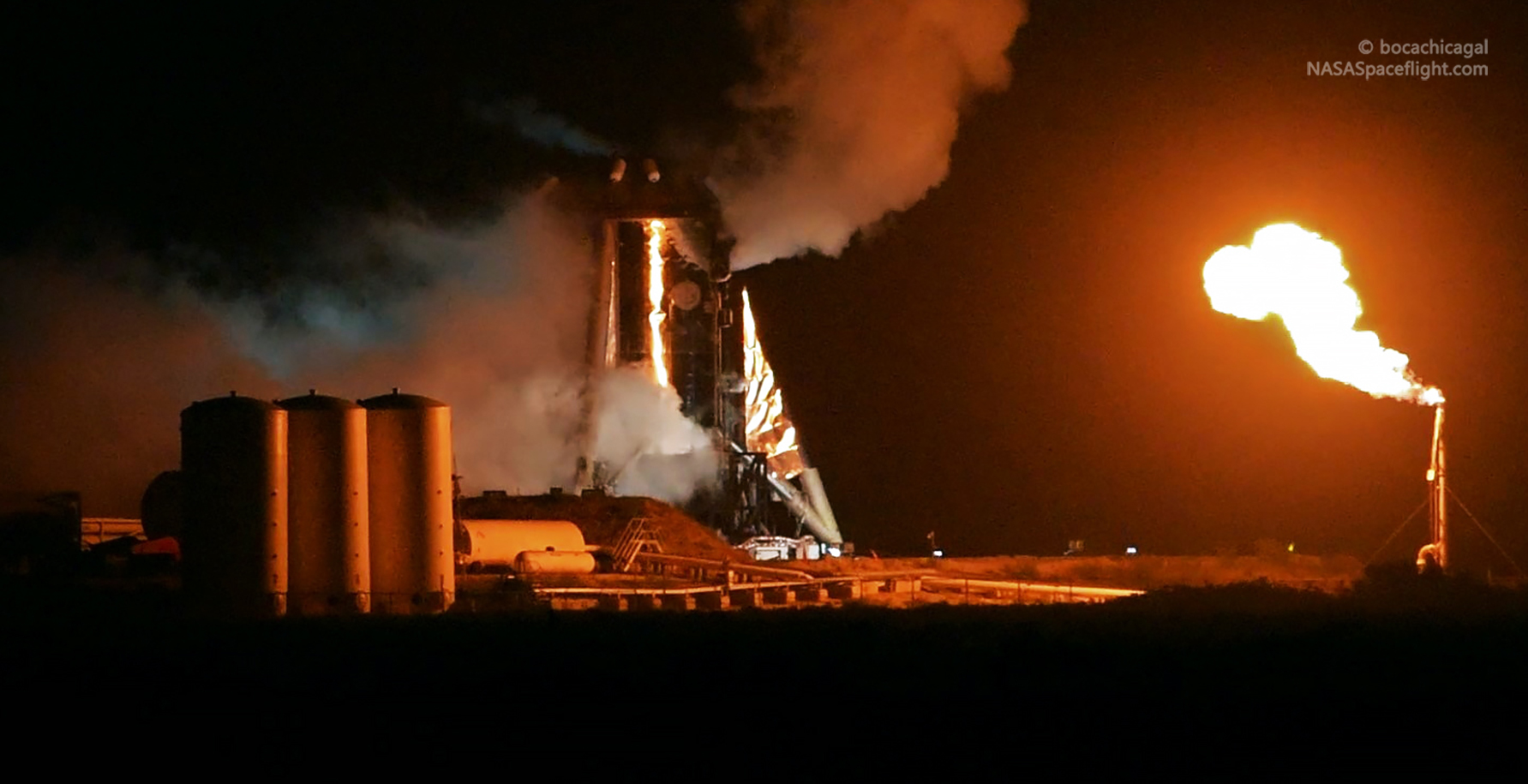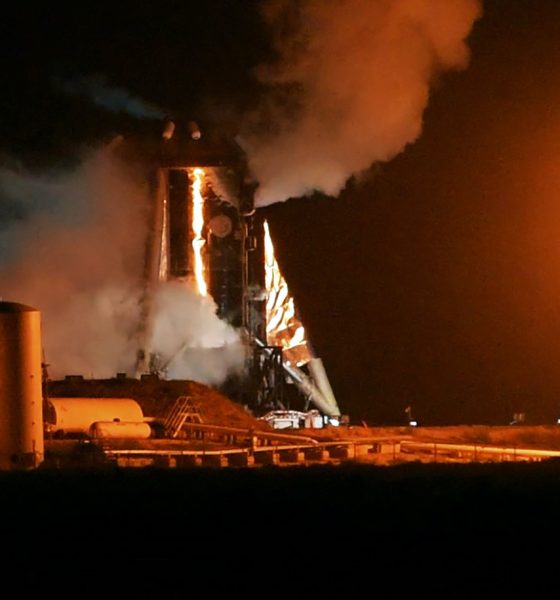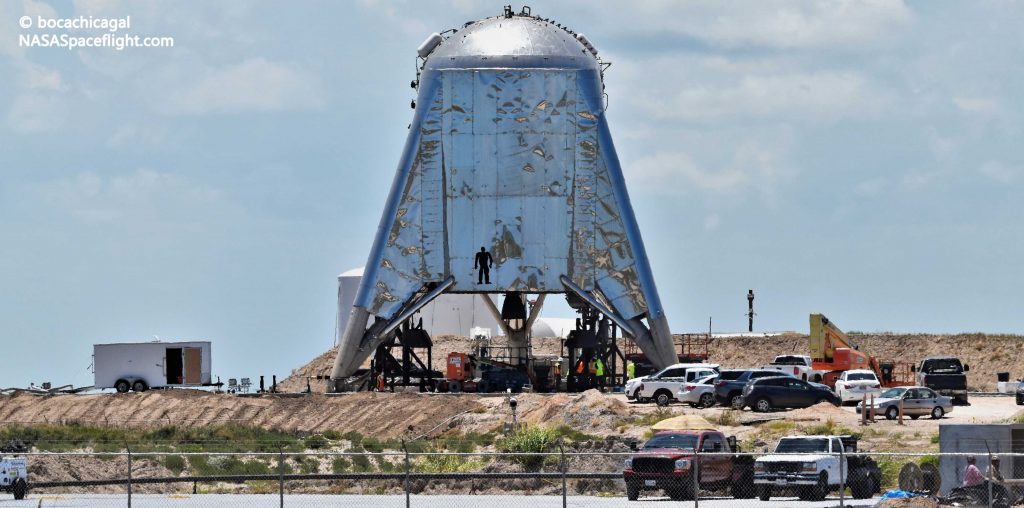

News
SpaceX’s next Starhopper flight needs more analysis for FAA go-ahead, says Elon Musk
According to SpaceX CEO Elon Musk, the company’s next major Starhopper flight test is still awaiting FAA approval due to a need for more hazard analysis, presumably required because Starhopper will be traveling much higher than before.
On August 9th, SpaceX completed a routine wet dress rehearsal (WDR) with Starhopper, loading the vehicle with propellant and fluids and replicating a launch countdown up to the point of Raptor ignition. Starhopper remains untethered in a sign that SpaceX doesn’t have plans for a static fire test before the low-fidelity rocket prototype’s next flight milestone. Originally scheduled for August 12th, that milestone – a 200m (650 ft) hop test – has been indefinitely delayed as SpaceX awaits an updated permit from the Federal Aviation Administration (FAA).
The oddity of the apparent difficulty SpaceX is having with the FAA’s experimental permit process is deepened by the fact that Starhopper is already permitted by the FAA and demonstrated its first successful flight just a few weeks ago, on July 25th. On top of the fact that the local Boca Chica and Brownsville, Texas airspace tends to be extremely quiet, it’s unclear what exactly is holding up SpaceX, the FAA, or both in what should otherwise be a relatively streamlined process.

A few weeks ago, after one false start on July 24th, Starhopper performed its first untethered flight ever on July 25th, successfully demonstrating its integrated steel propellant tanks, avionics, software, and Raptor propulsion over the course of 20 or so seconds of flight. Starhopper’s inaugural flight was delayed at least several weeks by a major bug with SpaceX’s next-gen Raptor engine, described by Elon Musk as a problem with a certain frequency of vibration (i.e. mechanical resonance).
According to Musk, said resonance failure mode was effectively solved with unspecified modifications made to the sixth Raptor engine produce (Raptor SN06). That engine became the first to successfully pass SpaceX’s regime of pre-hop static fires in McGregor, Texas around July 10th and was shipped south to Boca Chica and installed on Starhopper scarcely 24 hours later.
Assuming those vibration issues have been completely quashed, Musk has also stated that SpaceX is aiming to produce as many as two Raptor engines per day by the end of 2019. It’s believed that all engines preceding SN06 (SN01-05) were either damaged or destroyed during testing, be that a result of intentional testing-to-destruction or anomalous behavior during certain test regimes. It should be noted that full-scale Raptor is still undoubtedly in development and hardware failure during developmental testing is more predictable and valuable than it might seem. As long as the program can handle it, ‘hardware-rich’ development (i.e. moving fast and breaking things) can be equally – if not more – valuable than an extremely cautious get-it-right-the-first-time approach.
Regardless, once SpaceX’s propulsion engineering team is confident that the more major bugs that plagued early Raptor engines have been alleviated, they will likely give the go-ahead for the engine manufacturing team to begin ramping production rates. Musk believes that SpaceX could be ready for the first test flights of either or both of the company’s orbital Mk1 and Mk1 Starship prototypes as early as mid-September, milestones that will eventually require three sea-level Raptor engines and up to three vacuum Raptor engines per rocket.
Meanwhile, although SpaceX has yet to begin assembling the first Super Heavy booster(s), said boosters will require dozens of Raptor engines each for their first flights. Musk says that SpaceX will start out with something like 20 Raptor engines per booster to minimize losses and disruption in the event of a catastrophic failure, eventually expanding to as many as 35 engines per booster as confidence grows.
For now, Starhopper’s next flight test was scheduled from August 16th through the 18th but has since been tentatively rescheduled to Aug. 19-21. Starhopper will remain grounded until the FAA is satisfied with SpaceX’s updated hazard analyses for the rocket’s 200m flight test.
Check out Teslarati’s Marketplace! We offer Tesla accessories, including for the Tesla Cybertruck and Tesla Model 3.

Elon Musk
Elon Musk’s X will start using a Tesla-like software update strategy
The initiative seems designed to accelerate updates to the social media platform, while maintaining maximum transparency.

Elon Musk’s social media platform X will adopt a Tesla-esque approach to software updates for its algorithm.
The initiative seems designed to accelerate updates to the social media platform, while maintaining maximum transparency.
X’s updates to its updates
As per Musk in a post on X, the social media company will be making a new algorithm to determine what organic and advertising posts are recommended to users. These updates would then be repeated every four weeks.
“We will make the new 𝕏 algorithm, including all code used to determine what organic and advertising posts are recommended to users, open source in 7 days. This will be repeated every 4 weeks, with comprehensive developer notes, to help you understand what changed,” Musk wrote in his post.
The initiative somewhat mirrors Tesla’s over-the-air update model, where vehicle software is regularly refined and pushed to users with detailed release notes. This should allow users to better understand the details of X’s every update and foster a healthy feedback loop for the social media platform.
xAI and X
X, formerly Twitter, has been acquired by Elon Musk’s artificial intelligence startup, xAI last year. Since then, xAI has seen a rapid rise in valuation. Following the company’s the company’s upsized $20 billion Series E funding round, estimates now suggest that xAI is worth tens about $230 to $235 billion. That’s several times larger than Tesla when Elon Musk received his controversial 2018 CEO Performance Award.
As per xAI, the Series E funding round attracted a diverse group of investors, including Valor Equity Partners, Stepstone Group, Fidelity Management & Research Company, Qatar Investment Authority, MGX, and Baron Capital Group, among others. Strategic partners NVIDIA and Cisco Investments also continued support for building the world’s largest GPU clusters.
News
Tesla FSD Supervised wins MotorTrend’s Best Driver Assistance Award
The decision marks a notable reversal for the publication from prior years, with judges citing major real-world improvements that pushed Tesla’s latest FSD software ahead of every competing ADAS system.

Tesla’s Full Self-Driving (Supervised) system has been named the best driver-assistance technology on the market, earning top honors at the 2026 MotorTrend Best Tech Awards.
The decision marks a notable reversal for the publication from prior years, with judges citing major real-world improvements that pushed Tesla’s latest FSD software ahead of every competing ADAS system. And it wasn’t even close.
MotorTrend reverses course
MotorTrend awarded Tesla FSD (Supervised) its 2026 Best Tech Driver Assistance title after extensive testing of the latest v14 software. The publication acknowledged that it had previously criticized earlier versions of FSD for erratic behavior and near-miss incidents, ultimately favoring rivals such as GM’s Super Cruise in earlier evaluations.
According to MotorTrend, the newest iteration of FSD resolved many of those shortcomings. Testers said v14 showed far smoother behavior in complex urban scenarios, including unprotected left turns, traffic circles, emergency vehicles, and dense city streets. While the system still requires constant driver supervision, judges concluded that no other advanced driver-assistance system currently matches its breadth of capability.
Unlike rival systems that rely on combinations of cameras, radar, lidar, and mapped highways, Tesla’s FSD operates using a camera-only approach and is capable of driving on city streets, rural roads, and freeways. MotorTrend stated that pure utility, the ability to handle nearly all road types, ultimately separated FSD from competitors like Ford BlueCruise, GM Super Cruise, and BMW’s Highway Assistant.
High cost and high capability
MotorTrend also addressed FSD’s pricing, which remains significantly higher than rival systems. Tesla currently charges $8,000 for a one-time purchase or $99 per month for a subscription, compared with far lower upfront and subscription costs from other automakers. The publication noted that the premium is justified given FSD’s unmatched scope and continuous software evolution.
Safety remained a central focus of the evaluation. While testers reported collision-free operation over thousands of miles, they noted ongoing concerns around FSD’s configurable driving modes, including options that allow aggressive driving and speeds beyond posted limits. MotorTrend emphasized that, like all Level 2 systems, FSD still depends on a fully attentive human driver at all times.
Despite those caveats, the publication concluded that Tesla’s rapid software progress fundamentally reshaped the competitive landscape. For drivers seeking the most capable hands-on driver-assistance system available today, MotorTrend concluded Tesla FSD (Supervised) now stands alone at the top.
News
Elon Musk’s Grokipedia surges to 5.6M articles, almost 79% of English Wikipedia
The explosive growth marks a major milestone for the AI-powered online encyclopedia, which was launched by Elon Musk’s xAI just months ago.

Elon Musk’s Grokipedia has grown to an impressive 5,615,201 articles as of today, closing in on 79% of the English Wikipedia’s current total of 7,119,376 articles.
The explosive growth marks a major milestone for the AI-powered online encyclopedia, which was launched by Elon Musk’s xAI just months ago. Needless to say, it would only be a matter of time before Grokipedia exceeds English Wikipedia in sheer volume.
Grokipedia’s rapid growth
xAI’s vision for Grokipedia emphasizes neutrality, while Grok’s reasoning capabilities allow for fast drafting and fact-checking. When Elon Musk announced the initiative in late September 2025, he noted that Grokipedia would be an improvement to Wikipedia because it would be designed to avoid bias.
At the time, Musk noted that Grokipedia “is a necessary step towards the xAI goal of understanding the Universe.”
Grokipedia was launched in late October, and while xAI was careful to list it only as Version 0.1 at the time, the online encyclopedia immediately earned praise. Wikipedia co-founder Larry Sanger highlighted the project’s innovative approach, noting how it leverages AI to fill knowledge gaps and enable rapid updates. Netizens also observed how Grokipedia tends to present articles in a more objective manner compared to Wikipedia, which is edited by humans.
Elon Musk’s ambitious plans
With 5,615,201 total articles, Grokipedia has now grown to almost 79% of English Wikipedia’s article base. This is incredibly quick, though Grokipedia remains text-only for now. xAI, for its part, has now updated the online encyclopedia’s iteration to v0.2.
Elon Musk has shared bold ideas for Grokipedia, including sending a record of the entire knowledge base to space as part of xAI’s mission to preserve and expand human understanding. At some point, Musk stated that Grokipedia will be renamed to Encyclopedia Galactica, and it will be sent to the cosmos.
“When Grokipedia is good enough (long way to go), we will change the name to Encyclopedia Galactica. It will be an open source distillation of all knowledge, including audio, images and video. Join xAI to help build the sci-fi version of the Library of Alexandria!” Musk wrote, adding in a later post that “Copies will be etched in stone and sent to the Moon, Mars and beyond. This time, it will not be lost.”








